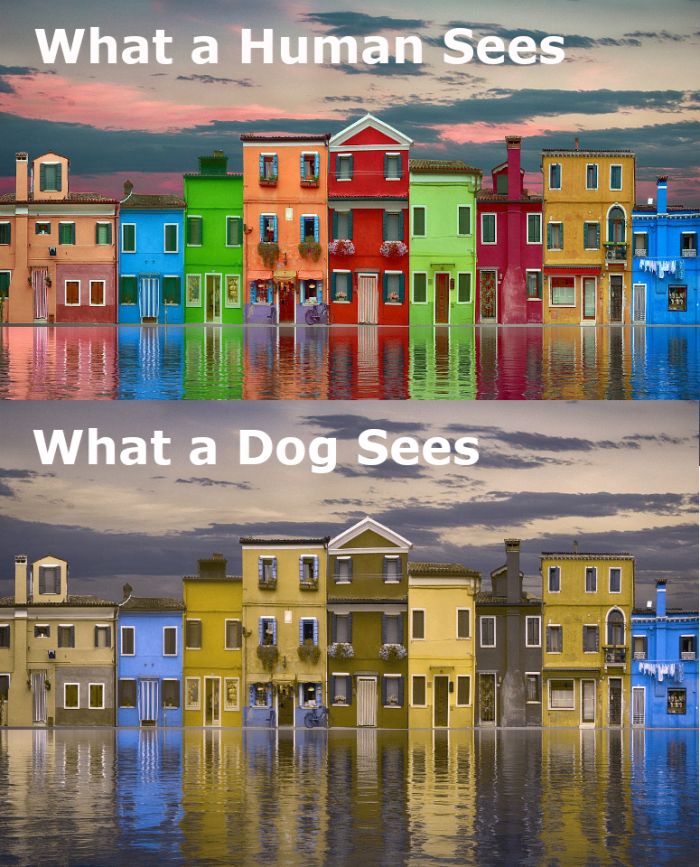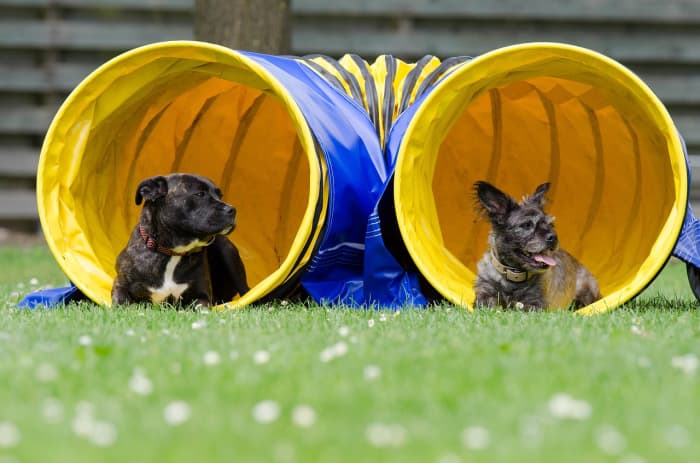What Type of Color Blind Are Dogs
Robert is a life-long dog-lover and the co-creator of Telemark's Guide to Dogs, an interactive CD-ROM filled with dog information & photos.

Pixabay (editted)
Are Dogs Really Color Blind?
Most dog lovers know that the answer to the question, "Are dogs color blind?" is "Yes, dogs are color blind." But that doesn't mean what you may think. For many years, it was commonly believed that dogs saw the world in tones of gray, like an old black-and-white photograph or TV image. That belief can probably be attributed to Will Judy (founder of National Dog Week), who wrote in a 1937 dog-training manual that dogs could only see shades of gray. Will was a widely published author, so his views quickly spread.
The view was supported by many scientists who until the 1960s generally believed that only primates and a few species of birds had the ability to see colors. Today, through experimentation and through a better understanding of the eye, we know that many animals have color vision, but few can perceive the full range of colors seen by humans.
Dogs, in particular, have red-green color blindness, which is also the most common form of colorblindness in humans. Dogs can see blues and yellows much like we do, but greens and reds are seen as shades of brown or gray… much like the picture at the top of this page.
How Dog and Human Eyes Differ
Our eyes have two types of light receptors called rods and cones. Rods are simply light detectors, whereas cones respond to different frequencies of light (in other words, different colors).
- Humans are trichromatic. We have three types of cones, which correspond roughly to red, blue, and green.
- Dogs, on the other hand, are dichromatic . They have two types of cones that correspond roughly to blue and yellow.
Dogs have a higher percentage of rods than humans. That means dogs are better at seeing in low-light conditions. Due to the high percentage of rods, dogs are also better at detecting motion.
However, dogs are quite nearsighted by human standards. Most dogs have the equivalent of about 20/75 vision. A dog could only read the first three lines of an optometrist's eye chart (although reading an eye chart at all would be quite a feat for a dog!) Dogs see close-up objects much as humans do, but distant objects are very blurry.

This is how a dog really sees the world.
What This Means for You and Your Dog
Bright red dog toys look great to humans but are pretty dull for your dog. Who wants to play with a gray toy? If you toss a red ball in a field of grass, it's very hard for your dog to see. (Unless it's still rolling . . . remember, your dog is great at seeing motion.) Look for blue and yellow toys, which look bright and exciting to dogs, and are easy for them to see.
The world of dog agility is also starting to recognize dogs' visual limitations. Dog agility equipment are now using blue and yellow as the main colors more frequently. Many dog agility organizations have now established rules that landing surfaces and contact zones should be painted yellow, with contrasting areas in blue. Another alternative is to stick with black and white, using white for contact surfaces, and black for contrast.
Read More From Pethelpful

Modern agility equipment is often colored yellow and blue, colors which dogs see well.
Do All Dogs See Alike?
Surprisingly, there is almost no data to answer this question. Scientists have not studied the differences in vision among different dog breeds.
While it's doubtful that any breed has independently evolved trichromatic color vision, it's quite likely that some breeds have sharper vision that others, just as some breeds have a better sense of smell. And of course, just as in humans, eyesight will vary from individual to individual.
Don't Feel Sorry for Your Dog
While dogs can't compete with humans when it comes to seeing, their other senses are far better than ours. Dogs can detect sounds at about four times the distance that humans can hear. They can also hear much higher frequencies (67–45,000 Hz, versus a human range of 64–23,000 Hz). Dogs have more muscles in their ears, allowing them to move their ears to better detect the direction of sounds.
Dogs have 150–300 million scent receptors, depending on the breeds, compared to 5 million for humans. The portion of the dog's brain devote to analyzing scents is about 40 times as great as a human's. Scientists estimate that a dog's sense of smell may be 10,000 to 100,000 times better than a human's. To put this in perspective, a human might detect the sweet scent of a teaspoon of sugar in a cup of coffee . . . but a dog can smell a teaspoon of sugar added to an Olympic swimming pool!
Due to the differences in our senses, dogs and humans experience the world differently. Understanding the differences can help us be better friends and companions.
This article is accurate and true to the best of the author's knowledge. It is not meant to substitute for diagnosis, prognosis, treatment, prescription, or formal and individualized advice from a veterinary medical professional. Animals exhibiting signs and symptoms of distress should be seen by a veterinarian immediately.
© 2019 Robert Nicholson
Ariana Riel on October 12, 2019:
Me too. But dogs don't know that. Because they were born to see these colors. It's normal for them.
Bailey Loyd on October 09, 2019:
Boy, do I feel bad for dogs
What Type of Color Blind Are Dogs
Source: https://pethelpful.com/dogs/Are-Dogs-Color-Blind